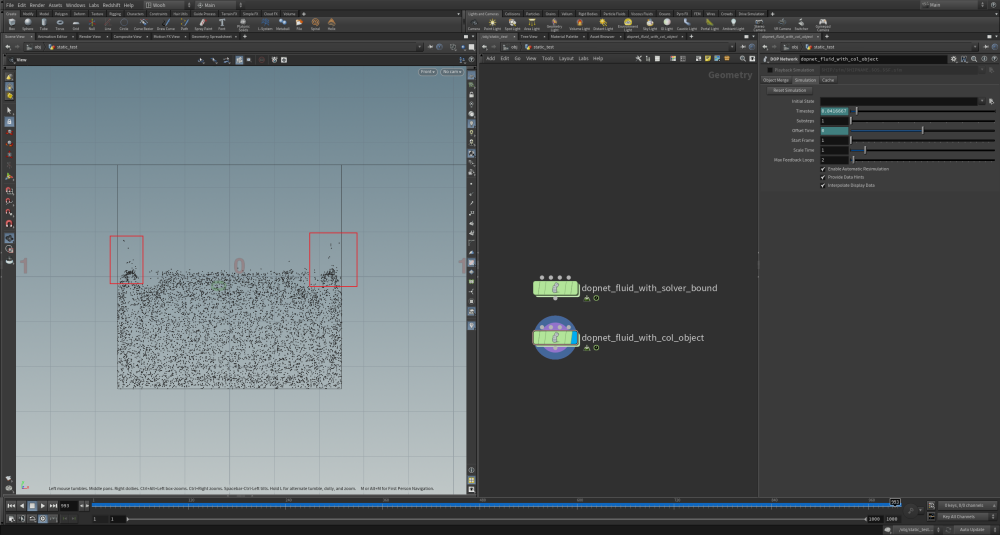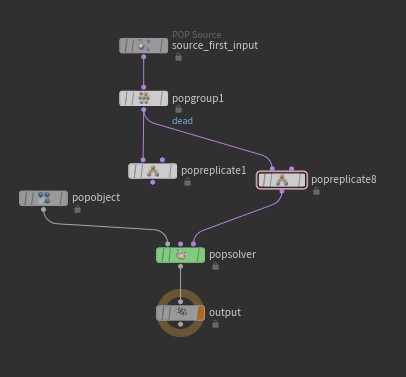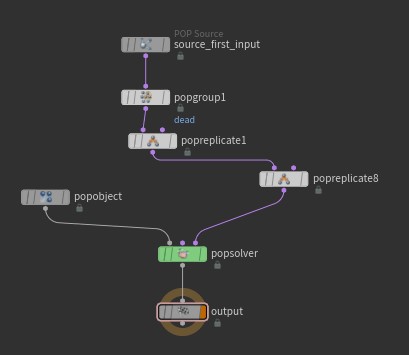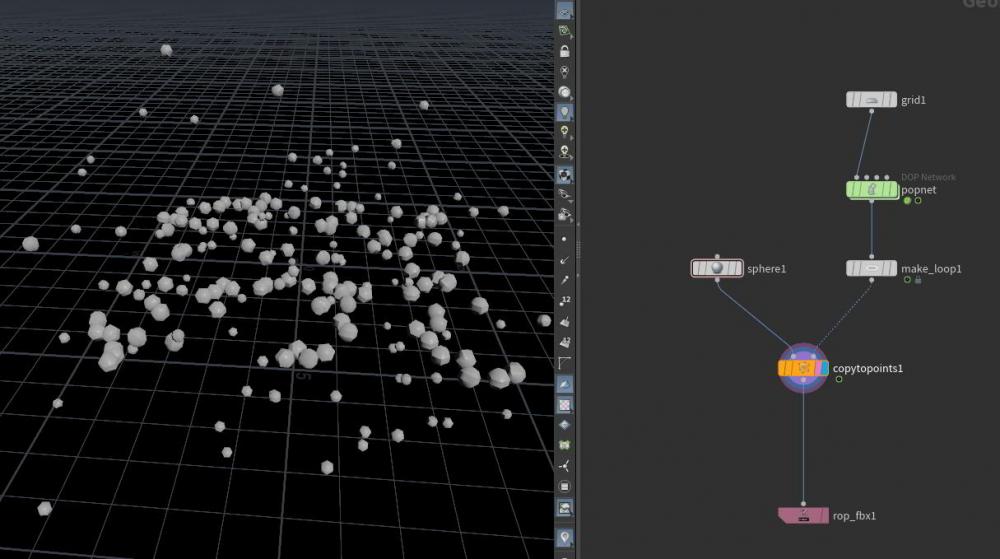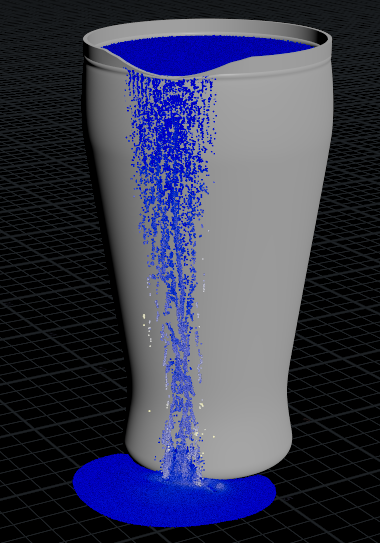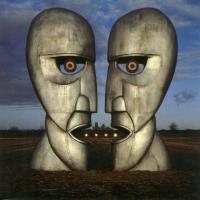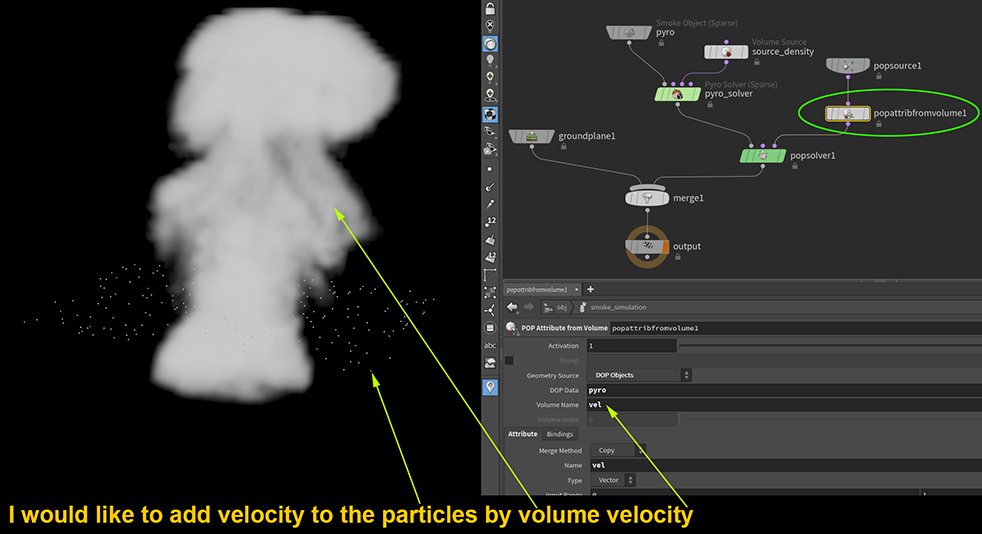Search the Community
Showing results for tags 'particle'.
-
Hi, I'd like to set up a simulation where there's a small container, and half of it will be filled with liquid. The initial state of the liquid should be static, like a cup of water left on the table for a long time. Then I'll introduce a rigid object to collide with the liquid. Sounds simple, right? But what's puzzling me is how to achieve the static state of the water before the impact of the rigid object. I created the container and converted the lower half of its volume into flip particles, then applied gravity. What happened next was that the behavior of the particles at the collision volume junction wasn't as normal as expected. They kept jittering, and as the simulation continued, the jittering became even more intense. Whether it's what I expected or what happens in the real world, the water should become more and more static as time goes by. However, with gravity turned on in the DOPNET, I can't make them completely calm. I found that if I adjust the size of the flip solver volume limits to replace the role of the container and turn on the flip object's closed boundary option, the particles at the boundary junction don't jitter as much. As time passes, the performance of all fluid particles becomes increasingly calm. This is exactly the effect I'm looking for. However, this method only works with cube-shaped containers. If I use a spherical or tubular container, it doesn't solve the problem. So, how can we truly eliminate the jittering of flip particles at the collision volume junction? Below is my .hip file. Thank you all very much. TANKtest.hip
-
I need to create an effect of the glow passing through as in the reference video. I tried to use torus to animate it through but it doesn't really seem to give off the effect. does anyone have other methods to share? ref.mp4
-
- houdini19.5
- glow
-
(and 3 more)
Tagged with:
-
does anyone know how am I able to create the black space in the middle of the beam in the image attached? the final outcome that i need to make is attached in the video. i used scatter and point vop to create the beam but can't seem to recreate the inner part of it Beamfx.mp4 TestSim_V01.mp4
-
I want to make fireworks using pop network in houdini. So I made particles that go up. It is calculated in "popreplicate1" And I wanted to make particles that come out when source particles are dead. So I made a group named "dead" and replicate a dead group. This node structure runs well (I forgot merging) But this node structure is not working properly I think the problem is that the group has a problem as the stream has changed. After completing the operation at the first input of merge, do we continue to use the stream of the first input when moving on to the second input? I want to know what the problem is.
-
Hello, I'm trying to do a particle morph effect and all I want to do is to have the animated data imported into the pop network. The effect is from a tutorial by Nicolas Donatelli (https://www.youtube.com/watch?v=B4Zz8Erc09E). Morphing works great but only works on a static geometry and I would like the animated data to be imported as well. It probably an easy solution, would be great if someone could figure it out. Attached is my HIP file with animated geo. I've tried the pop attract node which does the job but it can be quite tricky to control. ParticleMorph_WIP_1.hiplc
-
Hey there, I am trying to get an effect of an art directed shockwave done. In my particular case I am trying to shape the shockwave in the shape of a heart going outwards. I literally have no Idea how to get this effect going. I was thinking about feeding my animated shape into a pop network where I create the particles aswell as the necessary attributes for the pyro solver. Has anybody here an idea how to archieve this kind of effect. In my thinking there needs to be a way to get this to work with any kind of shape. I am thankful for any advice helping me out!!! (I am relatively new to Houdini, started last year and focused more on some vellum sims. Now I want to expand my skillset with some personal projects adressing different parts of the software)
-
i am trying to use the volume gradient - volume sample method to keep moving particles inside a volume. The particles move freely with a noise but as soon as they reach the edge they should turn. Doesn't seem right so far sdf_bounds.hip
-
Hi all. This should be easy, but it's killing me... I have a control object living outside a DOP network, a simple particle system. I've plugged it into the second input. Inside the DOP I access this control position without issue, in a VOP. However I then want to follow up by killing particles in a POP wrangle, based on distance to the control object... Easy right? Here's my vex: f@dist = distance(@P, v@opinput0_P); if ( @dist <= ch("threshold")) { removepoint(0,@ptnum);} ... simple. But it kills particles around the origin, not the control object, as if v@opinput0_P = {0,0,0} I've tried multiple variants on opinput, explicit path and the point function etc but it always gives me a "kill" radius around the origin, not the control object. Anyone see what I'm missing? Thanks in advance!
-
I am simulating a beer overflow and somehow I can't get all the particles to slide down the collision geometry, which creates artifacts when meshing the simulation. Friction is set to 0 for both the flip object and staticObject (not animated), stickOnCollision on the flipSolver/volumeMotion is off and I have also set collision detection to none under the flipSolver/ParticleMotion Any ideas of what to try? Thank you (All the blue particles on the side of the pint don't move much towards the end of the sim)
-
I want to achieve this kind of but my smoke is not dissipating quickly. and im getting stretchy smoke. i reduce the velocity to 0.1 still im getting that line shape smoke. sorry for bad english. i cant upload Hip file because of restriction. any suggestion should be helpful
-
Hey magicians, Just saw this fantastic spot by Lewis Orton and I was wondering how to achieve this effect where the particles are calm and explode up (sec 0:9 and 0:22), I tried with a ripple sop to drive the particles but the effect is very poor (and particles go up and down instead of up only, tried vector to float here with no luck) Any tip to get me on direction will be really helpful! Thanks!
-
Hello Houdini Masters! I'm having trouble with finding a starting point for creating a beam of energy being shot out of the barrel of a weapon. I haven't worked with particles much, but I don't really understand how all those particles become something so clean as a solid beam of "energy". I have some reference as to what i would want the beam to look like: (lilo & stich - the green ray from Jumba's gun): (WoW: Legion trailer - Sylvanas's arrows she's shooting) If anyone has any links to tutorials, articles explaining the process for this, or has any first hand experience working with partcles/"energy"beams your help would be most appreciated. Thanks in advance
-
Hello everyone! The guys need help how to slow down or stop a particle based on its age. That is, the more her age. the slower she moved and then stopped altogether deceleration.hip
-
Hello, I have noob question. Is there a way to emit the geometry surrounded by the red line as collide particles? Thank you collide particle.hipnc
-
i am working on the firework effect. i emitted some particle by pop locate and they replicate some particles when dead. Each original particle has orginal id and the id is inherited to replicated particles. What i want to do is assign the normal vector of Geometry( sphere) to the velocity of replicated particles and adjust them along the each original id. so i decided to iterate over original id with For loop inside popnet. I made array list of original id and each id inside the array is taken by Find attribute value count and again loop over with the count of point number that has each id on the array list. The point number that has certain id is bringing into the list called "plis" but the list is updating and deleting,adding new pointnumber. It is not accumulating. how can i fix this ? - my array isn't accumulating but adding one point number and updating the others repeatedly. and Do i complicate the process to make little bit simple effect ?
-
Hi! I am a bit newbie, sry. I have to flip particles of a grid by 360 degrees, controlled by a null swiping through the grid. Here is my solution so far. Unfortunately I can not solve the 360 degree flip properly. It would be good to have some randomization of flip axis on it too. I wuld like to make some randomization on the scale too. Could you give me some hints on it , or perhaps edit my scene , please? Thanks in advance. Robert Flip particles on grid_10.hip
-
Hi. I am currently working on an effect for tracer bullets on a fighter plane and I was wondering if there is any way to make the emission more controllable? Currently in my popnet I have 2 pop sources, one with probabilistic emission which creates a random emission pattern and one with it off so it emits particles at a constant speed. I have a switch setup so I can animate which emission method is used, but its either one or the other. I would like to be able to mix these 2 pop sources together so I could have a constant emission with added randomness created from the probabilistic source. ex: (20% of probabilistic, 80% constant or vice versa) Thanks hip file: machinegunfire_fx_ODforce_v012.hipnc
-
Hi; I would like to add some velocity to particles from a volume (smoke), so I tried to use "POP Attribute from volume", but it doesn't work. How can I fix it? Actually, "POP advect from volume" works, but I would like to ADD/Multiply the velocity to particles, not advect them. Thanks for helping. POP_Attribute_from_Volume.hip
- 5 replies
-
- popattributefromvolume
- particle
-
(and 2 more)
Tagged with:
-
Hi, Currently, I'm working on a small sim where a character gradually fills up with water. I'm trying to have more control over the emission rate, when using the emit particle fluid shelf tool. It seems like the "Scale Source Volume" slider on the Volume Source DOP has been removed. Normally, it would be found below the "Activation" slider. I attached a screenshot of the parameter view of said node. So, my question is as follows: where can I find a similar parameter in Houdini 18? Best regards
-
Hey guys, how can I do something like this but within a pop network? Thx
- 7 replies
-
- particle
- transformation
-
(and 1 more)
Tagged with:
-
Hello all, I am quite new with Houdini, just started in the beginning of this month. I enjoy Houdini very much, however, I encounter a problem here and have been here for quite some time. So what I want to do it basically make a scene of a ball crashing a wall and then have debris coming out of the wall as the effect of the crashing and the wall being torn down. Well basically want to get this to the next level. However, I have been looking for a way to do this and found somethings but maybe because I still need to learn more about Houdini, I do not really get how to do this properly. So I thought I can start from a simpler scene first. Firstly I read a post hereand have tried to do it step by step and even try to mimic the scene exactly but I still have no luck. I use Houdini 12 so I grabbed the torus_debris_h12_fix.hip file. I did everything as exactly as how it is in the file, but as from what I check, I see that the "delete" from the particle_location1 does not work properly (If what I see is correct). Although I see this problem, I have no idea how to fix it since I think all is correct I attached my file here. can anyone help me on this? and maybe if you know a tutorial that can be helpful for me to get the hang of this? Thanks in advance houdini_29-09try.hipnc
-
Hi, I am importing an Alembic particle sequence from realflow. Shows up great in Houdini, no problems there. I want to 'mesh' it, I was thinking I would convert it to VDB and then to polys to have maximum control however the 'VDB from Particles' node is not taking the alembic particles (ie. nothing happens). Do I need to convert them to something else before? Am I approaching this completely wrong? Much obliged,
-
guys , i got a big trouble, 1——let's say we have a model . the choose of model is important,models that are not rigorous enough will not expose the problem. generally 1)loop topology 2)parallel lines with changes in density(lines get close or far),like image below (there is a hip file i used attached below) 2——and now we want particles move along the direction like image below 3——that's it ----------------------------------------------------------------------------------------------------- what i have tried is using the 【calculated v attribute on model】 to make a velocity volume to advect particles or directly using 【the calculated v attribute on model】 to change the particle‘s v attribute continually , maybe plus minpos() locking in the end. but either failed , both make the particles have small inward deviation or outward deviation on velocity direction at every step/frame due to centrifugal force/inertia and finally make particles stick together. what i want to achieve is particles move along these directon and the motion/trail of particles don't have any shift/offset/deviation. all i tried just a very small part of the solutions, if you guys have any other great solution that can get the effect, please help ,it drives me crazy particles move along topology direction_TEST_MODEL.hip inward_deviation.mp4 inward deviation single.mp4

